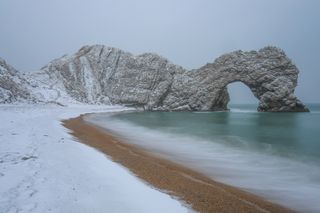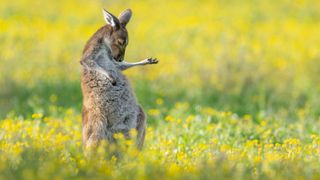This unique photograph is showing the famous Durdle Door on England's Jurassic Coast in a completely different light. Titled Durdle Door in the Snow, photographer Matt Pinner captured the scene in March 2018, when the storm Emma, also known as the Beast from the East, reminded us of the power of nature as it brought snowfall and cold temperatures to the UK.
Shot with a Canon 5D Mark IV and a Canon EF 16-35mm f/2.8L III USM with an Lee Filters 0.6 ND soft grad and polariser. The exposure was 1.5sec at f/9, ISO100).
1. Contrary elements
One way to make photos stand out is to recognize unusual situations that add a further visual layer to the scene. “When the ‘beast from the east’ was predicted to hit the UK, I couldn’t resist shooting this famous landmark in the snow – I knew it probably wouldn’t happen again for a very long time,” says Matt.
The contrary elements are balanced out perfectly and make the landscape even more special. “This image has the effect of inner peace. I captured this scene to show that there is calm at the eye of the storm,” he says.
2. Leading lines
Matt’s composition directs the viewer’s gaze towards the focal point through a mix of straight and rough organic lines. “The shoreline is highlighted by the crispness of the snow and the rich sea green water,” Matt says. “Between these was some sea foam and exposed sand, creating a pathway to the rock itself,” he adds.
To emphasise the focal point of the composition, Matt captured as much of the foreground as possible. “I went close to the water’s edge to help elongate the image and maximise the surroundings.”
3. Muted tones
The calming effect of this photograph is mainly due to the muted colour palette. “The grey and green against the blue and white all balance out to create an atmosphere that reflects the solidity of the rock itself,” says Matt.
He aims to let his work express itself by doing the minimal amount of editing possible. “I didn’t work on anything specific, other than lowering overall highlights and upping the shadows. You should let images be as organic as they can,” Matt says. Capturing the best image in-camera means he can avoid time-consuming editing processes.
4. Strong structures
Durdle Door has a distinct shape that dominates the surrounding landscape. “I used the long exposure technique to create the illusion of the sea being frozen to build a connection between sea and snow,” says Matt. With this method, he contrasts both elements and draws out the characteristics of the stone.
“The smooth sand and curved lines of the shore draw the eye to the hard texture of the rock formation,” he adds. With this decision, Matt has created an interesting interplay between the various structures in the picture.

Matt Pinner is a British landscape photographer based in Dorset, UK. He has worked with numerous clients including Canon, The Times, Toyota and others. Matt offers one-to-one workshops for budding landscape photographers and publishes books and calendars featuring nature images shot from a distinctive perspective.
“My love of photography was inspired by my late grandfather, who always went out with his camera. When he died, I bought a camera and I’ve never looked back.”
- "On this shoot, the rain and the strong wind were my biggest enemies”
- Photographer tells story of getting up close and personal with a python
- “I chose the ND filter to avoid overexposure and control the powerful glow"
- Urban street photographer reveals his candid capture secrets
- "I don't use any external flash, this image is shot purely with natural light"
- Photographer tells story of his amazing shot of wallabies fighting
- The 4 photographic decisions that take this motorsport shot to the next level







